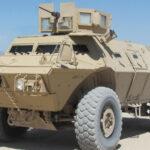At the Association of the United States Army (AUSA) 2025 Annual Meeting in Washington D.C., Epirus unveiled a new evolution of its high-power microwave (HPM) weapon system: the Leonidas Autonomous. Mounted on an unmanned ground vehicle (UGV), this latest iteration combines directed energy counter-unmanned aerial system (C-UAS) capabilities with autonomous mobility and AI-driven targeting. The platform marks a significant step toward scalable, mobile electronic warfare solutions for short-range air defense (SHORAD).
Leonidas Evolution: From Fixed to Mobile to Fully Autonomous
Epirus first introduced the Leonidas HPM system in 2020 as a trailer-mounted directed energy weapon designed to neutralize drone swarms by disrupting their electronics. In subsequent years, the company demonstrated mobile variants integrated on Stryker infantry carrier vehicles and other tactical platforms. The core technology relies on solid-state gallium nitride (GaN) amplifiers that generate precise bursts of high-power microwaves capable of disabling multiple drones simultaneously without kinetic munitions.
The newly unveiled Leonidas Autonomous represents a leap forward by integrating this capability onto a robotic ground platform—specifically a purpose-built tracked UGV developed in partnership with HDT Global. This enables fully unmanned operations in contested environments where human operators may be at risk or unavailable. The system is equipped with sensors and AI algorithms for autonomous navigation and target acquisition.
Platform Details: UGV Integration and Autonomy Features
The robotic base for Leonidas Autonomous is derived from HDT Global’s Hunter WOLF UGV architecture—a modular tracked vehicle designed for expeditionary operations. It provides sufficient onboard power generation and cooling to support the energy-intensive HPM payload while maintaining mobility across rough terrain.
Key features of the integrated system include:
- 360° threat detection: EO/IR sensors and radar provide situational awareness for autonomous targeting.
- AI-enabled engagement logic: Machine learning algorithms prioritize threats based on swarm behavior and proximity.
- Silent operation: Unlike kinetic SHORAD systems, HPM systems are non-lethal to humans and produce no explosive signature.
- Crewless deployment: Remote or pre-programmed missions reduce operator exposure in forward areas.
The UGV can operate independently or as part of a networked sensor-effector mesh—receiving cues from external radar or C2 nodes via secure datalinks.
Directed Energy Capabilities Against Drone Swarms
The core strength of Leonidas lies in its ability to neutralize entire drone swarms with a single pulse. Unlike laser-based directed energy weapons that must dwell on each target individually, HPM systems emit wide-area electromagnetic pulses that can simultaneously disable multiple UAVs by frying their onboard electronics or disrupting their flight control systems.
This makes them particularly suited to countering low-cost commercial drones used en masse by adversaries—an emerging threat vector seen in conflicts such as Ukraine and Syria. According to Epirus, field trials have shown that Leonidas can disable dozens of drones per burst within a radius of several hundred meters depending on atmospheric conditions and drone type.
Tactical Role Within Future SHORAD Architectures
The U.S. Army has been actively pursuing layered SHORAD solutions combining kinetic interceptors (e.g., Stinger missiles), guns (e.g., M-SHORAD), and non-kinetic effectors like lasers and microwaves. The introduction of an autonomous HPM effector adds another layer—one optimized for rapid response against saturation attacks without expending finite munitions.
An autonomous C-UAS node like Leonidas could be deployed forward with maneuver units or positioned around critical infrastructure as part of base defense networks. Its low cost-per-shot and minimal logistics footprint make it attractive for persistent operations where traditional missile-based systems would be prohibitively expensive or unsustainable over time.
Program Status and Road Ahead
Epirus has not disclosed whether the U.S. Department of Defense has formally selected Leonidas Autonomous under any procurement program; however, the company confirmed at AUSA 2025 that it is engaged in multiple demonstrations with Army Futures Command and other service branches under rapid prototyping initiatives.
The firm also announced plans to integrate its SmartPower software-defined waveform control suite into future iterations—allowing dynamic tuning of beam shape, frequency modulation, and power levels based on mission parameters or evolving threats. This software-driven approach could enable real-time adaptation against novel drone designs employing hardened electronics or GNSS spoofing tactics.
Implications for Military Robotics and Electronic Warfare
The convergence of autonomy, robotics, artificial intelligence, and directed energy embodied by Leonidas Autonomous signals a broader shift toward machine-enabled electronic warfare capabilities. As military forces face increasingly complex aerial threats—including drone swarms operating below radar coverage—the demand for scalable non-kinetic defenses will likely grow across all domains.
If successfully fielded at scale, systems like Leonidas could reshape battlefield dynamics by providing silent area denial without risking collateral damage or exhausting limited interceptor stocks—a critical advantage in prolonged peer conflict scenarios where logistics chains are contested.
Conclusion
The debut of Epirus’ autonomous Leonidas robotic system at AUSA 2025 underscores how rapidly counter-drone technologies are evolving beyond static installations toward intelligent mobile platforms capable of independent action. While operational deployment timelines remain uncertain pending further testing and acquisition decisions, the concept represents a compelling vision for future force protection architectures grounded in speed-of-light effects rather than bullets or missiles alone.










